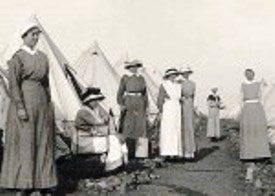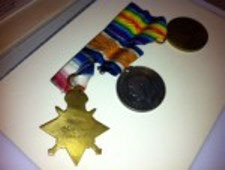There are many cases of brothers enlisting in the First AIF and in some cases serving together, but it is very unusual to find a brother and sister enlisting and to be then serving in the same theatre. Martin and Patricia Blundell did just this. They both served in Gallipoli in late 1915 – Martin fighting on the Gallipoli Peninsula and Patricia tending the sick and injured on Lemnos Island. This is their story.
Madeline Patricia Blundell was born on 17 March 1880 at South Yarra; trained as a nurse and worked at the Royal Children’s Hospital for three years between 1911 and 1914. In October 1914 she accepted a position as the Matron of the Royal Military College Duntroon in Canberra and worked there until she enlisted in the Australian Army Nursing Service in May 1915.
Martin was born in Melbourne on the 15 March 1891 and attended Melbourne Grammar School for two years from 1903 to 1904 and Geelong Grammar School for four years between 1904 and 1907. He excelled in sport playing for the Firsts in both rugby and cricket. He became a member of the Melbourne Cricket Club in 1911. He worked at the Australasia Bank for a short time – the same bank as his father – then moved to the Riverina and later Queensland. He enlisted in the AIF at age 24 in Rockhampton on 26 January 1915. Martin was tall and well developed with good riding skills and allotted to the 7th Reinforcements for the 4th Light Horse Regiment.
The 4th Light Horse Regiment was raised in Melbourne on the 14 August 1914 as the divisional cavalry Regiment for the 1st Australian Division. Its first Commanding Officer was Lieutenant Colonel John Forsyth. A Light Horse regiment normally consisted of 25 officers and 497 other ranks serving in three Squadrons each of six troops. These troops were divided into eight sections of four men each. However the 4th Light Horse eventually raised five squadrons. After the Gallipoli campaign, two of these squadrons were detached to France while the other three remained in the Middle East serving with the Australian and New Zealand (Anzac) Mounted Division. Martin was part of B squadron that was sent to France.
Patricia enlisted a few months later on 5 May 1915 and embarked from Melbourne on RMS Mooltan on 18 May 1915. Coincidentally on the same day Martin embarked on AMS Persia from Sydney.
Patricia disembarked in London on 27 June 1915 and was then posted to the 3rd Australian General Hospital (AGH) at Mudros, on the Greek Island of Lemnos off the coast of Gallipoli, on 5 August 1915.

Martin staged through Egypt and was taken on strength with B Squadron of the 4th Light Horse Regiment at Gallipoli on 24 October 1915. Not long after arriving at Gallipoli Martin developed mumps and was granted two weeks sick leave.
Martin re-joined his unit at Gallipoli on 22 November 1915. On the 11th December 1915 the 4th Light Horse Regiment was evacuated from Gallipoli.
This is where the siblings’ service intersects. Martin’s Regiment was evacuated from Anzac Cove on the 11 December 1915 to Mudros where he was able to meet his sister Patricia who was based at the 3rd AGH. Martin’s diary and letters to his mother tell of many visits to Patricia at the hospital for tea. It must have been one of the more pleasant times they had together, even for such a short time and under trying conditions. Yet sadly, this will be the last time that they would ever see each other.
B and D squadrons of the 4th Light Horse Regiment sailed from Alexandria on the SS Caledonia to join the British Expeditionary Force in France, arriving at Marseilles on 27 March 1916. Martin was taken on strength and by 3 September 1917 he was promoted to Lance Corporal.
The two squadrons of the 4th Light Horse Regiment by this time had been assigned as the corps cavalry formation for II ANZAC. These two Australian squadrons together with a squadron from New Zealand eventually amalgamated and were renamed II ANZAC Mounted Regiment and, later, the XXII Corps Mounted Regiment when the Corps was renumbered after its Australian infantry divisions departed to join the Australian Corps in late 1917.
By the end of 1917 it was evident that the entry of the United States into the war on the side of the Allies would mean the German Army would be simply outnumbered. However, the Brest-Litovsk Treaty signed on 3 March 1918 freed up some 700,000 German soldiers from the Russian front. Ludendorff, the German commander, decided on one last throw of the dice and planned a series of major assaults across the Western Front utilizing these additional troops.
Martin was granted leave and no doubt enjoyed seven days in Paris in February 1918 and a further two weeks in London in March 1918.
The first battle of Kemmel on the Belgian frontier began on 16 April 1918 and involved XXII Corps Mounted Regiment. At dawn on 17 April 1918 the Germans launched a thunderous assault on Merkem and Kippe from the Houthulst Forest. The German attack broke through and for a short time it appeared to the German High Command that what they had been attempting since 1914, the outflanking and roll up of the enemy line, might just happen. However, the Belgians counter attacked with vigour and succeeded in driving the Germans back and re-establishing the original front line – capturing over 800 German prisoners and some 60 machine guns.
The line south of Mont Kemmel was held in a thin defensive line by the British 19th Division. At 8.30 a.m. on 18 April 1918, following two and a half hours of bombardment, the German infantry attacked the British lines, but were beaten off and failed to break through.
That evening the French 28th Division relieved the 19th Division and took over responsibility for the front Line at Kemmel and the hill itself. On this occasion the XXII Corps Mounted Regiment was attached to French forces. Assisting with the relief in place at Mont Kemmel Martin Blundell was killed in action on 18 April 1918. His casualty report states “Killed in action near the summit of Mont Kemmel whilst acting as liaison between regiment and the French. The dug out which he was in was demolished by shell fire. His body was never recovered.”
Martin’s worldly goods were sent back to his mother in May 1918; they consisted of a set of nail scissors, a handkerchief, a strop and two soap cases.
A request for information on his death and grave site from his mother in early 1922 received the following reply: “Australian Grave Services formally advise it has not been possible either to locate his actual burial place or obtain information which might indicate his probable original or present resting place.”
Martin is remembered on the Roll of Honour Board at Geelong Grammar, the Melbourne Cricket Club and the Australian War Memorial. He is listed on Panel 7 at the Ypres (Menin Gate) Memorial.
The 4th Light Horse Regiment suffered 105 killed at Gallipoli and in the Sinai-Palestine campaign. While those parts of the 4th Light Horse that formed the II ANZAC (XXII Corps) Mounted Regiment lost 45 killed on the Western Front.
After Lemnos, Patricia continued to serve with the 3rd AGH at Abbassia outside Cairo. The Hospital left Egypt for Malta on the 12 August 1916 and arrived in London in October 1916. Patricia then had several posting to various hospitals including the Kitchener War Hospital in Brighton and in January 1917 was posted to the 2nd AGH at Winereux in France. After a year she returned back to England sick with bronchitis and spent time at the Southwell Gardens Hospital. She never fully recovered and was returned to Australia on the 18 July 1918 on the SS Baringa.
However, Patricia’s war was not over as the Baringa was torpedoed in the Bay of Biscay. She survived the attack and was returned to England. Eventually, she returns home to Australia on the SS Boonah arriving back in Melbourne on the 29 September 1918.
On returning to Melbourne she applied to the Army Medical Board for discharge, explaining that she is feeling ‘very tired out’. On 20 February 1919 the Army Medical Board ruled that she had no permanent disability, and suggesting it will take six months for her health to improve, they recommended a discharge as permanently unfit – that is, not able to re-enlist.

There is no record of Patricia ever marrying and she remained active in later life. Travelling first class to London on the SS Iberia in 1955, she is listed as single, and a housewife. In 1963 she was living at 255 Domain Road, South Yarra which is a very palatial property. Madeline Patricia Blundell died in 1968 aged 88 at her South Yarra property after a very full life.
Contact Peter Fielding about this article.






